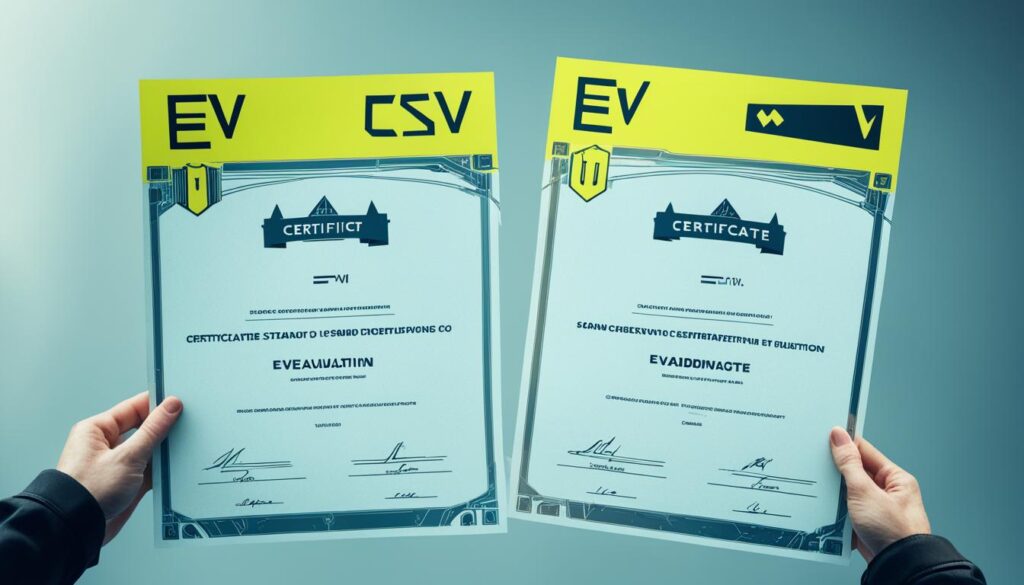Did you know that a staggering 97% of users cannot distinguish a sophisticated phishing attack from a genuine request? This unsettling statistic underscores the critical importance of digital trust, especially in the realm of software downloads. Two main gatekeepers of such trust are EV (Extended Validation) and Standard Code Signing Certificates. Both serve to validate a publisher’s identity, but how they execute this task, and the level of security they provide vary significantly—bearing consequential implications for developers and users alike. The oft-debated topic of EV vs Standard Code Signing Certificates boils down to understanding the foundational differences between them—the extended validation code signing vs standard code signing, and the trade-offs between an EV certificate vs standard certificate for code signing.
Key Takeaways
- Understanding the validation depth and private key storage that differentiate EV and Standard Code Signing Certificates.
- Recognizing the extra layer of security and user trust afforded by EV Code Signing Certificates.
- Gauging the suitability of Standard Code Signing Certificates for geographically dispersed development teams.
- Assessing the balance between cost, convenience, and security in choosing between EV and Standard Certificates.
- Identifying the benefits that come with the Microsoft SmartScreen filter trust linked to EV Certificates.
- Comparing hardware token-based key storage benefits versus local key storage for code signing security.
Understanding Code Signing Certificates
In an age where cyber threats loom around every corner, understanding the significance of code signing certificates is crucial for anyone in the software development and distribution ecosystem. These digital certificates are not just about improving software security; they play an instrumental role in preserving software integrity and maintaining the delicate balance of trust between developers and end-users.

Securing Software in a Digital World
As we navigate a digital landscape that is saturated with applications and software, the distinct difference between EV and standard code signing becomes a focal point. These certificates differ fundamentally in their approach to validation, which has direct implications for the level of trust and security associated with signed software. But at the core of both types is the endeavor to safeguard the software from being compromised and to protect the integrity of the code.
The Role of Code Signing in User Protection
The commitment to user protection is inherently built into the very fabric of code signing certificates. Serving as gatekeepers, these certificates ensure that users are downloading authentic software, untouched by malicious intent. By verifying the source and ensuring code integrity, these digital certificates shield end-users from the perils of malware that could otherwise compromise personal data and system security.
Here’s a glance at the key differences between EV and Standard Code Signing Certificates which play a pivotal role in ensuring software integrity:
| Feature | EV Code Signing | Standard Code Signing |
|---|---|---|
| Identity Validation Level | Extensive business vetting | Basic organizational validation |
| Private Key Security | Hardware token storage | Local machine storage |
| User Trust | Higher, benefits from Microsoft SmartScreen | Standard, without immediate SmartScreen recognition |
| Issuance Time | Longer due to rigorous checks | Quicker with minimal validation steps |
| Use Case | Suitable for high-profile software | Ideal for smaller-scale projects |
Understanding these nuances plays a key role in making an informed decision when it comes to selecting the right type of code signing certificate for a particular software product. Not only do these distinctions impact the ease of deployment, but they also shape the perception of trustworthiness and reliability in the eyes of the users. Consequently, the choice between an EV and a standard certificate is not just a technicality—it’s a strategic decision that could define a software’s success and credibility in the market.
Overview of EV Code Signing Certificates
The Extended Validation (EV) Code Signing Certificate represents the pinnacle of security within the realm of software protection and trustworthiness. By embracing the EV code signing benefits, developers and organizations can ensure their applications are met with a heightened degree of confidence by both users and systems. It’s the exclusive union of two key elements: a painstakingly rigorous vetting process and the benefits of hardware token-based key storage that cements the reputation of an EV certificate as the gold standard in the industry.
The Rigorous Vetting Process for EV Code Signing
Obtaining an extended validation code signing certificate involves a meticulous examination to confirm the legitimacy of the requesting entity. This process is not just a cursory glance but a deep dive by the Certificate Authorities (CAs) to verify the entity’s legal, operational, and physical existence. Each EV Code Signing Certificate carries with it the guarantee that considerable effort has been exerted to validate the developer’s authenticity, resulting in a level of trust that far surpasses that of standard code signing certificates.
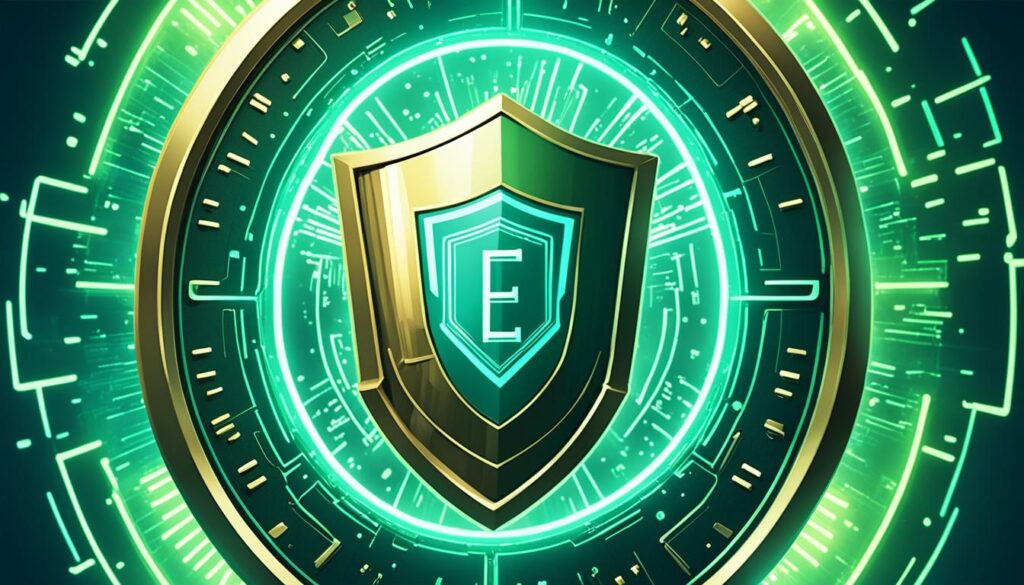
Benefits of Hardware Token-Based Key Storage
A defining characteristic of an EV Code Signing Certificate is the requirement that the private key be securely stored on a hardware token. This physical device is mailed to the certificate’s owner and is imperative in eliminating multiple vectors of potential unauthorized access. The strict isolation of the private key not only amplifies security but also visibly demonstrates to customers and partners alike the measures taken by an organization to safeguard their interests and the integrity of their software.
The Process Behind Standard Code Signing Certificates
As the digital realm evolves, the security of software has become a critical element for developers and businesses. Standard Code Signing Certificates serve as an essential tool to affirm the credibility and integrity of software, offering a balance between security and efficiency. In this section, we explore the procedures that these certificates entail.
Validation Techniques and Certificate Issuance
The issuance of a Standard Code Signing Certificate is predicated on an Organization Validation (OV) protocol. This procedure confirms the identity of the software publisher to a certain degree. While OV is not as exhaustive as the verification process used for Extended Validation (EV) Certificates, it is a standardized form of authentication that bolsters users’ trust in software integrity. OV Certificates typically cater to established developers and organizations that are recognized within the industry. The standard code signing comparison shows that these certificates are a more accessible option, favoring swift deployment and flexibility in various software development scenarios.
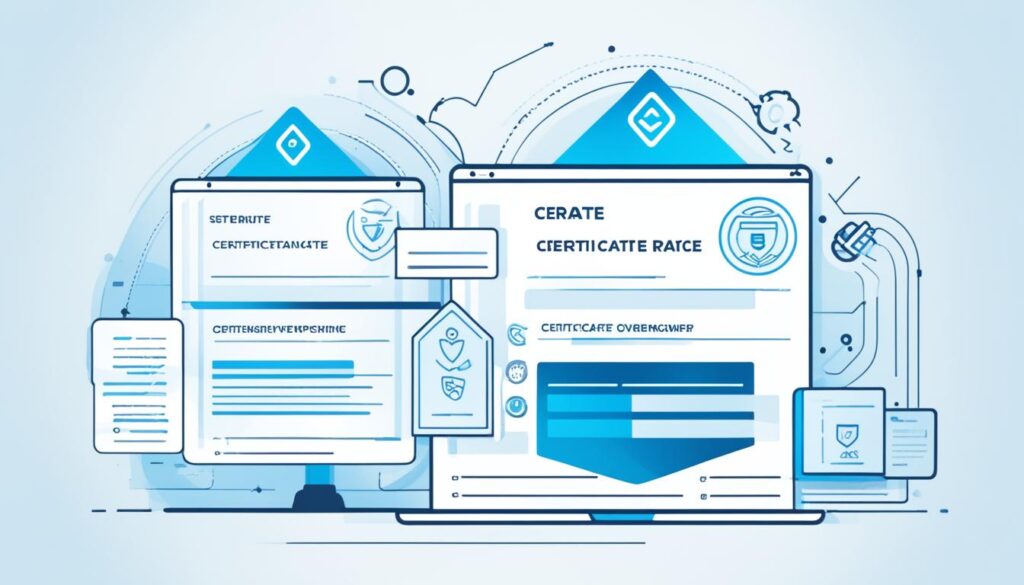
Implications of Local Key Storage
One of the distinctive aspects of the Standard Code Signing Certificate is the local key storage mechanism. Unlike the hardware token storage used in EV Code Signing, the local storage means that the private keys are maintained on the developer’s workstation. Although this offers convenience and direct control, it raises potential security concerns. If the developer’s system is compromised, it could lead to unauthorized access to the keys. Consequently, encrypting the private key and employing comprehensive security practices become imperative to protect the software from tampering or misuse.
Standard Certificates emphasize adaptability and are particularly beneficial for developers who need to respond rapidly to market demands or software updates. Their support for multiple platforms and ease of integration make them a practical choice for a diverse range of software applications that need to maintain a recognized level of authenticity without the higher security thresholds required by EV Certificates.
EV vs Standard Code Signing Certificates: A Comparative Analysis
When delving into the world of software security, understanding the difference between EV vs standard digital certificates is critical for developers and organizations. Enhanced security protocols and user trust stand at the forefront of Extended Validation (EV) and Standard Code Signing Certificates. We’ll explore the advantages each type offers, their validity period, and how they cater to different needs within the digital landscape.
| Feature | EV Code Signing Certificate | Standard Code Signing Certificate |
|---|---|---|
| Validation | Extensive identity verification ensures high trust levels. | Quick, minimal identity confirmation. |
| Private Key Storage | Hardware tokens restrict access and provides enhanced security. | Stored locally, offering flexibility with potential security risks. |
| Recognition by Microsoft SmartScreen | Instant trust upon first software launch. | Trust built over time through reputation. |
| Price | Higher cost, fit for robust IT budgets and long-term investment. | More affordable, attractive to small businesses and individuals. |
| Target Users | Suitable for enterprises and software providers requiring heightened security. | Ideal for independent developers and start-ups. |
The advantages of EV code signing are numerous and particularly beneficial for entities that prioritize establishing immediate trust. As users become increasingly security-conscious, the EV verification process reassures them of the software’s legitimacy and safety. Despite the higher price point, the return on investment is perceptible in the form of secure software distribution and heightened user confidence.
On the other side of the spectrum, the standard vs EV code signing comparison highlights the accessible nature of Standard Certificates. They serve as an entry point for those needing a quick and effective solution to assure end-users of code integrity without the stringent requirements and costs associated with EV certificates.
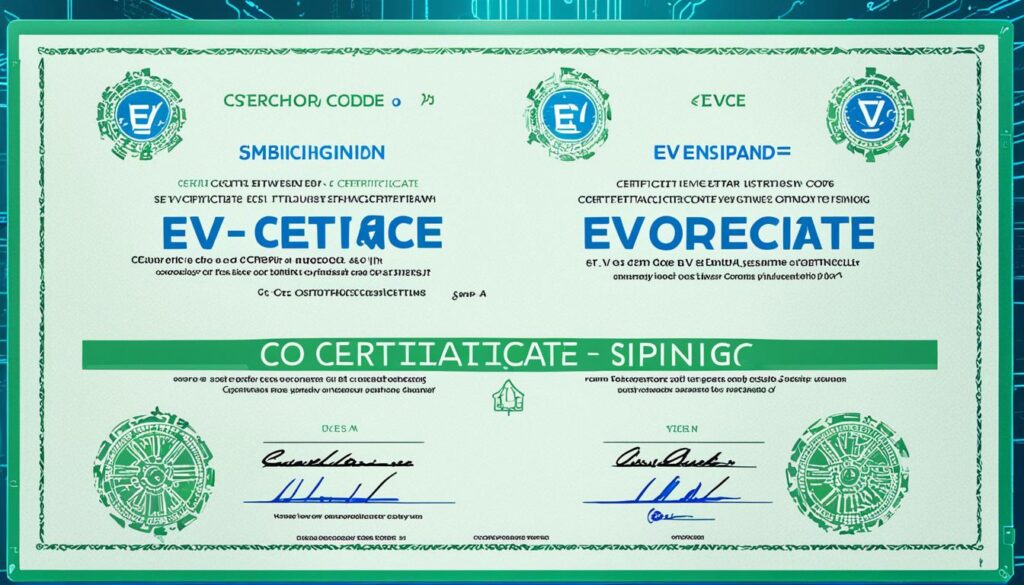
Ultimately, the choice between the two types of certificates will revolve around specific needs, projected growth, and the primary concern for security vs. cost. Taking the time to analyze these factors will lead to a better-informed decision that aligns with both current capabilities and future aspirations.
Advantages of EV Code Signing Certificates
For software publishers, the search for robust security solutions that foster trust and credibility without compromising on budget considerations leads many to opt for Extended Validation (EV) Code Signing Certificates. In this era where digital safety is paramount, the benefits of EV Code Signing stand out, offering superior protection and immediate assurance to software users.
Enhancing Repute with Microsoft SmartScreen Recognition
One of the seminal advantages of EV Code Signing is the instant reputation elevation provided by Microsoft SmartScreen. Upon the initial launch of an application, users are greeted with fewer security warnings if the software is signed with an EV Certificate. This is a significant respite from the common hurdles new developers face with Microsoft SmartScreen’s filters. The blend of an EV Code Signing Certificate and Microsoft SmartScreen recognition synergistically reinforces the safety net for end-users and signals a publisher’s dedication to secure a software release.
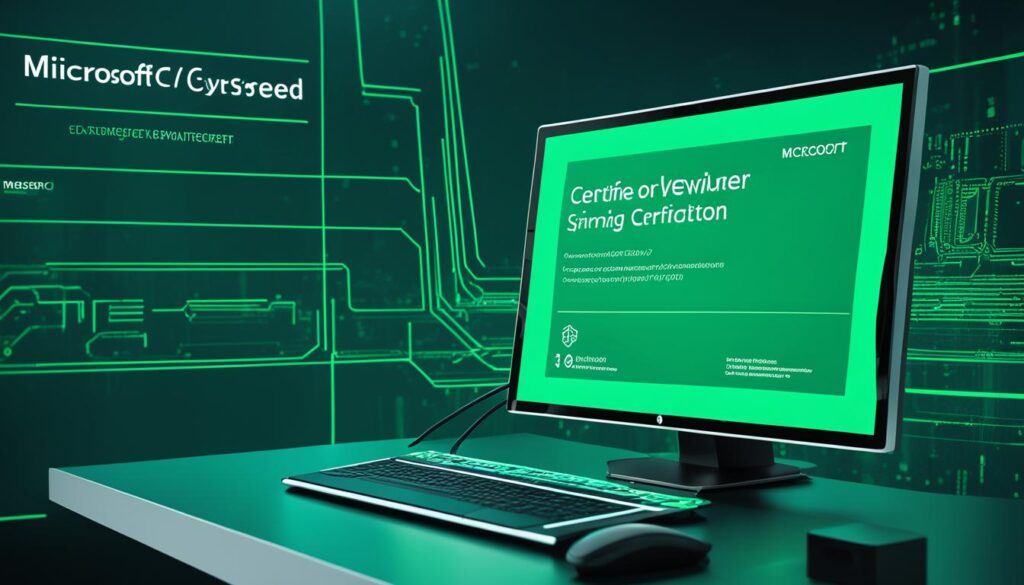
Long-Term Trust and Verification for Software Publishers
The implementation of EV Code Signing transcends beyond the immediate gains of improved reputation. It is an unequivocal declaration of a publisher’s commitment to long-term trustworthiness and integrity. This is largely due to the secure storage of signing keys on hardware tokens, which robustly defends against unauthorized access. Moreover, EV Certificates integrate seamlessly with major software platforms and are recognized for their automatic updates for Microsoft Authenticode and Kernel Mode, simplifying the publisher’s upkeep of the software’s trust-factor.
“Having an EV Code Signing Certificate is not just about establishing immediate trust; it’s a covenant with your user base for ongoing software integrity and security.”
The table below presents a compelling contrast between Standard and EV Code Signing Certificates, elucidating the key advantages for a software publisher when choosing EV over Standard Code Signing when it comes to Microsoft SmartScreen recognition and long-term trust.
| Feature | Standard Code Signing Certificate | EV Code Signing Certificate |
|---|---|---|
| Microsoft SmartScreen Recognition | Recognition builds over time with a reputation | Immediate recognition and trust |
| Validation Process | Organization Validation (OV) | Extended Validation (EV) |
| Private Key Storage | Local storage on developer’s machine | Hardware token storage with stringent access control |
| Platform Compatibility | Supports multiple platforms | Enhanced compatibility with major platforms |
| Cost Efficiency | Lower initial cost | Cost-effective in the long-term with lesser need for reputation building |
Conclusively, a standard code signing comparison reveals that the advantages of EV Code Signing, especially in conjunction with Microsoft SmartScreen recognition, offer a compelling case for its adoption. Software publishers gain not just a fortified defense against code tampering, but also an unquestionable affirmation of their authenticity to end-users.
A Closer Look at Standard Code Signing Comparison
When evaluating the standard code signing comparison, it’s important to recognize the balance of cost and benefit that these certificates bring to the table for developers. Typically, opting for an organizational validated code signing certificate is a strategic move, especially considering a developer’s budget and time constraints. With a focus on both code signing certificate’s affordability and efficient process management, Standard Code Signing Certificates remain a solid choice for many in the industry. Let’s delve into the details that make these certificates particularly appealing.
The Cost-Benefit Aspect for Developers
The saleability of Standard Code Signing Certificates lies in their ability to provide essential security without imposing the higher costs associated with more stringent certificate types. They serve as a testament to the developer’s credibility, yet do not necessitate the extensive verification procedures typical of their EV counterparts. This translates into a streamlined issuance process, which is especially critical when deployment schedules are tight.
The Role in Established Software Distribution
With the implementation of Standard Code Signing Certificates, businesses, especially those of small to mid-size stature, gain a competitive edge by reinforcing their reputation for distributing secure, credible software. The flexibility in managing updates and the capacity to deploy code across diverse platforms and devices underscore the value of Standard Certificates in established distribution channels.
Ultimately, the selection between an EV or a Standard Code Signing Certificate will often hinge upon specific project needs and the developer’s commitment to security versus speed and cost. What remains clear is that the latter offers a compelling proposition for those prioritizing expedience and fiscal prudence.
Evaluating the Need for Different Types of Code Signing
For software developers, the choice between extended validation code signing vs standard code signing is more than just a matter of cost or convenience. It involves a strategic consideration of several factors that align with the overarching goals of the project at hand. A nuanced understanding of these factors ensures that the security implemented will meet not only current needs but will also stand robust as technologies evolve and project scopes expand.
Key Considerations for Software Developers
Identifying the appropriate code signing certificate begins with assessing the project’s unique attributes and risks. Developers should weigh the importance of factors such as the criticality of the software to consumers, the potential damage a breach could cause, and how their choice may affect user trust. These assessments must be thorough, as the implications of code signing extend far beyond the immediate scope of deployment. The following points are central to this decision-making process:
- Level of required security based on the sensitivity of the software
- The reputation and size of the business issuing the software
- The nature and scale of the audience for which the software is intended
Choosing the Appropriate Certificate Based on Project Requirements
Opting for the suitable code signing certificate requires a close analysis of project-specific code signing needs. If the endeavor is a high-value software release that necessitates additional layers of security to enforce user trust, extended validation code signing provides that enhanced credibility. Conversely, a standard code signing certificate might be adequate for small scale developments, where rapid deployments and lower costs are crucial. Developers must consider these subtleties to ensure they are choosing the right code signing certificate:
- Understand the extent of vetting processes for both EV and Standard certificates.
- Ascertain compatibility with various user platforms and operating systems.
- Recognize the incremental trust that an EV code signing certificate builds over time through Microsoft SmartScreen and other reputation systems.
Finding the right balance between security, cost, and deployment efficiency is fundamental to making an informed decision between extended validation and standard code signing. With careful evaluation of the above factors, developers can safeguard their software, uphold their integrity, and maintain user trust.
Security Measures and Preventing Malware Breaches
The risks posed by cybersecurity attacks are more prevalent than ever, pushing the agenda for robust security measures to the forefront for businesses and software developers alike. With increasing instances of breaches, entrusted with safeguarding digital assets, developers must employ diligent practices to fortify the integrity of their software. Code Signing Certificates manifest as an instrumental tool in this regard, ensuring that any application distributed has not been tampered with and is authentic, directly impacting the confidence of end-users in the software they engage with.
Tackling the Rise of Insider Threats and External Attacks
In effectively tackling insider threats and external attacks, the adoption of secure code signing practices is essential. Extended Validation (EV) Code Signing Certificates, with their rigid security protocols, offer a significant layer of defense. These certificates go beyond standard validation procedures, implementing a rigorous authentication process that ensures only authorized individuals can access and utilize the private keys. Such measures are instrumental in mitigating the risks posed by insider transgressions, providing an effective barrier against potential breaches from within the organization.
Role of Code Signing in Preventing Malware Penetration
Concerning the prevention of malware with code signing, it is paramount to understand the dualistic role these certificates play. EV Code Signing Certificates are particularly potent in deterring the penetration of malicious software into legitimate applications, thanks to their comprehensive verification process and secure management of cryptographic keys. Alternatively, Standard Code Signing Certificates, although less equipped to combat misuse by insiders, serve as a swift and reliable method in affirming the code’s integrity for many developers. These practices form the crux of secure software dissemination and are key to maintaining user trust and adherence to cybersecurity standards.
FAQ
What are the key differences between EV and Standard Code Signing Certificates?
The main differences lie in the validation process and how the private keys are stored. EV Code Signing Certificates require a more rigorous vetting process, and private keys are secured on hardware tokens. Standard Code Signing Certificates often involve a quicker issuance process with local storage of private keys on developers’ workstations.
Why are Code Signing Certificates crucial in today’s digital landscape?
They play a vital role in securing software by verifying the integrity and authenticity of the code. This protects end-users from malicious software and maintains trust in the digital world where software downloads are incessant.
What makes the vetting process for EV Code Signing Certificates more secure?
EV Code Signing involves a comprehensive verification of the publisher’s legal, operational, and physical existence, ensuring that only legitimate and reputable entities can obtain these certificates. This extensive vetting underpins enhanced trust and security.
How does the secure hardware token-based storage benefit EV Code Signing Certificate holders?
Hardware tokens reduce the risk of private key theft or unauthorized use as they securely store the keys outside of the developer’s workstation, requiring physical possession to access the signing key.
What are the benefits and drawbacks of local key storage for Standard Code Signing?
Local key storage offers ease and flexibility for developers, especially when distributing software updates. However, the primary risk involves the potential for security breaches if the developer’s environment is compromised.
How does the Microsoft SmartScreen recognition affect EV Code Signing Certificate users?
Software signed with an EV Code Signing Certificate can gain immediate reputation with Microsoft SmartScreen, which results in fewer security warnings for users, enhancing trust in the signed application from its very first use.
Are there cost benefits to choosing a Standard Code Signing Certificate?
Yes, Standard Certificates are generally more affordable with quicker issuance times, making them an attractive option for small to mid-size businesses and developers who require a more straightforward, cost-effective solution for software signing.
What should software developers consider when choosing between EV and Standard Code Signing Certificates?
Developers should weigh the level of required security, the scale of their operations, the nature of the software being developed, and the level of trust they wish to establish with users. High-profile projects or those needing greater trust may lean towards EV Certificates, while smaller projects might opt for Standard Certificates.
How do EV Code Signing Certificates help in preventing malware breaches?
By enforcing stringent security practices, such as strict vetting and hardware token-based key storage, EV Code Signing Certificates mitigate both insider and external threats, reducing the chances of malware being introduced into the software distribution.
Can Standard Code Signing Certificates still provide adequate security against software tampering?
While they may not offer the same level of security measures as EV Certificates, Standard Code Signing Certificates do verify the integrity of the code, ensuring that it has not been altered since signing, thus playing a significant role in maintaining software safety.


